Instruction
NFL Quarterback gets a lesson in athletic posture
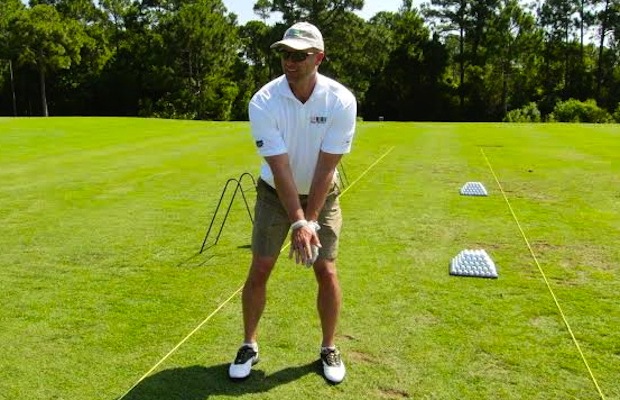
A quarterback in the NFL and a PGA Tour level player face a similar challenge. Although golfers aren’t dodging a blitz, players from both sports can create dynamics that alter performance and results without the player knowing consciously that something changed.
When I was a rookie Tour Pro, my coach was working with fellow Tour Pro Rick Fehr. He asked Rick why his setup was so deep in knee flex and leaned on his lead leg. Rick replied with a shrug of the shoulders. My coach then asked a great question, “Have you been playing in a lot of wind on tour lately?” Rick nodded in affirmation and revealed how he was moved to unconsciously alter his setup simply by the weather.
Recently, at the Strano Golf Academy in Florida, I taught an athlete in a similar situation. Retired several years from playing as a quarterback in the NFL, this past Heisman Trophy winner still looks like he could suit up and take some snaps. The former quarterback also possesses a passion for the game of golf, and came to me seeking improvement in areas in which he wasn’t seeing the results he wanted.
One of the keys to a good golf swing, or any physical movement, and it doesn’t matter if you are a PGA Tour winner, a Heisman winning NFL quarterback, or the backyard pickup game all star – athleticism in your set up is vital to success.
Using the technology on hand at the academy, I had him hit a few shots with a 7 iron. The FlightScope-BodiTrak read the pressure movements of his feet from setup through the finish, while the Flightscope X2 tracked all his club and ball data, giving me a full “MRI” of his swing. Below are the screenshots that I was able to show him:
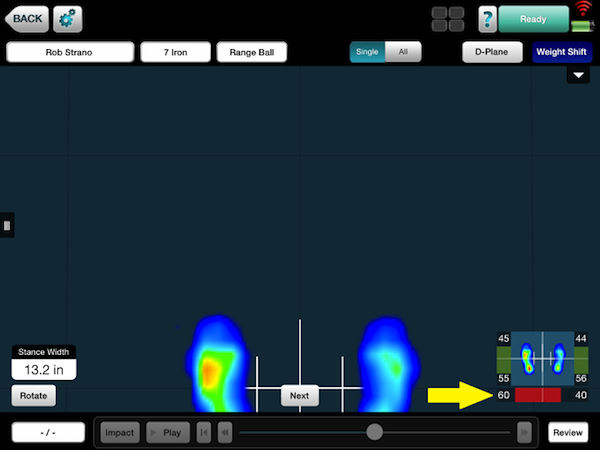
BodiTrak Pressure Mat readings showing lots of pressure to the left foot 60/40.
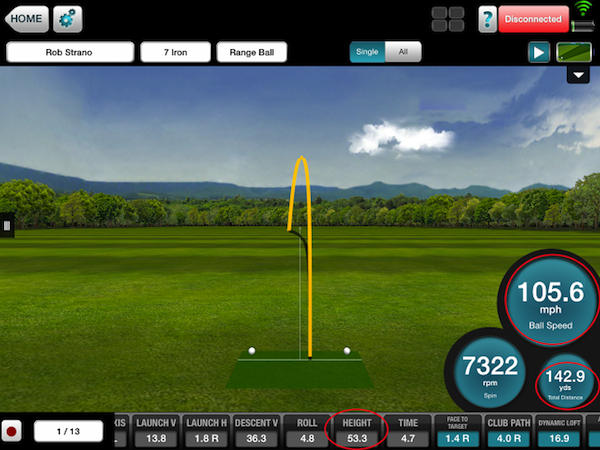
Flightscope screen readings showing ball speed, distance and height numbers as slow, short and low.
Once we finished reviewing the data and discussing the results, we got down to business to make him a better golfer. The first thing I did was get him in a position he was comfortable with as an elite athlete and quarterback; I had him get “under center” for me, pretending to take a snap, something he has done repeatedly throughout his life. He fell perfectly into equal pressure on both feet; similarly to if I stood talking to someone in casual conversation.
The images you see below show him before and after the adjustment. Before shows him in his normal golf posture, then him pretending to take a snap “under center,” using his golf stance. After shows him taking his position “under center,” then setting up the ball with a club using the football stance. This allowed him to visualize what mistakes he was making with his stance, and gave him the ability to make the proper adjustments to launch the ball higher.
Before After
The changes in ball flight, distance, and speed were dramatic and instantaneous. He was able to use his athleticism again to access the speed and power that were blocked by his previous setup. All the compensations he made to get the ball in the air went away and his launch conditions were greatly improved. When I showed him the Flightscope data after the new changes, his eyes lit up:
- Ball height went up from 53 ft to 91 ft (tour average)
- Ball Speed increased from 105 mph to 126 mph (which is a huge improvement)
- Distance overall jumped from 142 yards to 172 yards (equal to a three club increase)
To say he was pleased with his improvements would be an understatement. With an upcoming golf fundraiser that he was hosting, we needed to get his game to a level that would allow him to lead his golf team like he led his football teams in past competitions.
An important lesson to take from this is that good athletic setup pressures are all the same no matter the sport. The foot pressure of receiving a serve in tennis flows through basketball (guarding the player), baseball (ready position in the field), football (under center) and into golf (foot pressure at setup). The player, at any level of the game, has to be in an athletic position to move the stick they are swinging or make an athletic move to start any action. When your goal is to move the shaft/stick with as much speed as possible and still produce accuracy, then you need to be in a position where you can access your athletic ability.
Rob Strano is the Director of Instruction at the Strano Golf Academy in Destin, FL and a Flightscope Advisory Board Member. To learn more visit his website: www.stranogolf.com
[youtube id=”eH1TBYU0y5o” width=”620″ height=”360″]
- LIKE1
- LEGIT0
- WOW0
- LOL0
- IDHT0
- FLOP0
- OB0
- SHANK0
Instruction
The Wedge Guy: The easiest-to-learn golf basic

My golf learning began with this simple fact – if you don’t have a fundamentally sound hold on the golf club, it is practically impossible for your body to execute a fundamentally sound golf swing. I’m still a big believer that the golf swing is much easier to execute if you begin with the proper hold on the club.
As you might imagine, I come into contact with hundreds of golfers of all skill levels. And it is very rare to see a good player with a bad hold on the golf club. There are some exceptions, for sure, but they are very few and very far between, and they typically have beat so many balls with their poor grip that they’ve found a way to work around it.
The reality of biophysics is that the body moves only in certain ways – and the particulars of the way you hold the golf club can totally prevent a sound swing motion that allows the club to release properly through the impact zone. The wonderful thing is that anyone can learn how to put a fundamentally sound hold on the golf club, and you can practice it anywhere your hands are not otherwise engaged, like watching TV or just sitting and relaxing.
Whether you prefer an overlap, interlock or full-finger (not baseball!) grip on the club, the same fundamentals apply. Here are the major grip faults I see most often, in the order of the frequency:
Mis-aligned hands
By this I mean that the palms of the two hands are not parallel to each other. Too many golfers have a weak left hand and strong right, or vice versa. The easiest way to learn how to hold the club with your palms aligned properly is to grip a plain wooden ruler or yardstick. It forces the hands to align properly and shows you how that feels. If you grip and re-grip a yardstick several times, then grip a club, you’ll see that the learning curve is almost immediate.
The position of the grip in the upper/left hand
I also observe many golfers who have the butt of the grip too far into the heel pad of the upper hand (the left hand for right-handed players). It’s amazing how much easier it is to release the club through the ball if even 1/4-1/2″ of the butt is beyond the left heel pad. Try this yourself to see what I mean. Swing the club freely with just your left hand and notice the difference in its release from when you hold it at the end of the grip, versus gripping down even a half inch.
To help you really understand how this works, go to the range and hit shots with your five-iron gripped down a full inch to make the club the same length as your seven-iron. You will probably see an amazing shot shape difference, and likely not see as much distance loss as you would expect.
Too much lower (right) hand on the club
It seems like almost all golfers of 8-10 handicap or higher have the club too far into the palm of the lower hand, because that feels “good” if you are trying to control the path of the clubhead to the ball. But the golf swing is not an effort to hit at the ball – it is a swing of the club. The proper hold on the club has the grip underneath the pad at the base of the fingers. This will likely feel “weak” to you — like you cannot control the club like that. EXACTLY. You should not be trying to control the club with your lower/master hand.
Gripping too tightly
Nearly all golfers hold the club too tightly, which tenses up the forearms and prevents a proper release of the club through impact. In order for the club to move back and through properly, you must feel that the club is controlled by the last three fingers of the upper hand, and the middle two fingers of the lower hand. If you engage your thumbs and forefingers in “holding” the club, the result will almost always be a grip that is too tight. Try this for yourself. Hold the club in your upper hand only, and squeeze firmly with just the last three fingers, with the forefinger and thumb off the club entirely. You have good control, but your forearms are not tense. Then begin to squeeze down with your thumb and forefinger and observe the tensing of the entire forearm. This is the way we are made, so the key to preventing tenseness in the arms is to hold the club very lightly with the “pinchers” — the thumbs and forefingers.
So, those are what I believe are the four fundamentals of a good grip. Anyone can learn them in their home or office very quickly. There is no easier way to improve your ball striking consistency and add distance than giving more attention to the way you hold the golf club.
More from the Wedge Guy
- The Wedge Guy: Golf mastery begins with your wedge game
- The Wedge Guy: Why golf is 20 times harder than brain surgery
- The Wedge Guy: Musings on the golf ball rollback
- LIKE83
- LEGIT13
- WOW5
- LOL1
- IDHT0
- FLOP4
- OB1
- SHANK8
Instruction
Clement: Stop ripping off your swing with this drill!

Not the dreaded headcover under the armpit drill! As if your body is defective and can’t function by itself! Have you seen how incredible the human machine is with all the incredible feats of agility all kinds of athletes are accomplishing? You think your body is so defective (the good Lord is laughing his head off at you) that it needs a headcover tucked under the armpit so you can swing like T-Rex?
- LIKE0
- LEGIT2
- WOW2
- LOL0
- IDHT0
- FLOP0
- OB0
- SHANK2
Instruction
How a towel can fix your golf swing

This is a classic drill that has been used for decades. However, the world of marketed training aids has grown so much during that time that this simple practice has been virtually forgotten. Because why teach people how to play golf using everyday items when you can create and sell a product that reinforces the same thing? Nevertheless, I am here to give you helpful advice without running to the nearest Edwin Watts or adding something to your Amazon cart.
For the “scoring clubs,” having a solid connection between the arms and body during the swing, especially through impact, is paramount to creating long-lasting consistency. And keeping that connection throughout the swing helps rotate the shoulders more to generate more power to help you hit it farther. So, how does this drill work, and what will your game benefit from it? Well, let’s get into it.
Setup
You can use this for basic chip shots up to complete swings. I use this with every club in my bag, up to a 9 or 8-iron. It’s natural to create incrementally more separation between the arms and body as you progress up the set. So doing this with a high iron or a wood is not recommended.
While you set up to hit a ball, simply tuck the towel underneath both armpits. The length of the towel will determine how tight it will be across your chest but don’t make it so loose that it gets in the way of your vision. After both sides are tucked, make some focused swings, keeping both arms firmly connected to the body during the backswing and follow through. (Note: It’s normal to lose connection on your lead arm during your finishing pose.) When you’re ready, put a ball in the way of those swings and get to work.

Get a Better Shoulder Turn
Many of us struggle to have proper shoulder rotation in our golf swing, especially during long layoffs. Making a swing that is all arms and no shoulders is a surefire way to have less control with wedges and less distance with full swings. Notice how I can get in a similar-looking position in both 60° wedge photos. However, one is weak and uncontrollable, while the other is strong and connected. One allows me to use my larger muscles to create my swing, and one doesn’t. The follow-through is another critical point where having a good connection, as well as solid shoulder rotation, is a must. This drill is great for those who tend to have a “chicken wing” form in their lead arm, which happens when it becomes separated from the body through impact.
In full swings, getting your shoulders to rotate in your golf swing is a great way to reinforce proper weight distribution. If your swing is all arms, it’s much harder to get your weight to naturally shift to the inside part of your trail foot in the backswing. Sure, you could make the mistake of “sliding” to get weight on your back foot, but that doesn’t fix the issue. You must turn into your trial leg to generate power. Additionally, look at the difference in separation between my hands and my head in the 8-iron examples. The green picture has more separation and has my hands lower. This will help me lessen my angle of attack and make it easier to hit the inside part of the golf ball, rather than the over-the-top move that the other picture produces.


Stay Better Connected in the Backswing
When you don’t keep everything in your upper body working as one, getting to a good spot at the top of your swing is very hard to do. It would take impeccable timing along with great hand-eye coordination to hit quality shots with any sort of regularity if the arms are working separately from the body.
Notice in the red pictures of both my 60-degree wedge and 8-iron how high my hands are and the fact you can clearly see my shoulder through the gap in my arms. That has happened because the right arm, just above my elbow, has become totally disconnected from my body. That separation causes me to lift my hands as well as lose some of the extension in my left arm. This has been corrected in the green pictures by using this drill to reinforce that connection. It will also make you focus on keeping the lead arm close to your body as well. Because the moment either one loses that relationship, the towel falls.


Conclusion
I have been diligent this year in finding a few drills that target some of the issues that plague my golf game; either by simply forgetting fundamental things or by coming to terms with the faults that have bitten me my whole career. I have found that having a few drills to fall back on to reinforce certain feelings helps me find my game a little easier, and the “towel drill” is most definitely one of them.
- LIKE12
- LEGIT2
- WOW2
- LOL0
- IDHT0
- FLOP2
- OB0
- SHANK8
-

 19th Hole4 days ago
19th Hole4 days agoDave Portnoy places monstrous outright bet for the 2024 Masters
-

 19th Hole3 weeks ago
19th Hole3 weeks agoJohn Daly stuns fans into silence with brutal opening tee shot on PGA Tour Champions
-

 19th Hole2 weeks ago
19th Hole2 weeks agoThings got heated at the Houston Open between Tony Finau and Alejandro Tosti. Here’s why
-

 19th Hole5 days ago
19th Hole5 days agoTiger Woods arrives at 2024 Masters equipped with a putter that may surprise you
-

 19th Hole1 week ago
19th Hole1 week agoReport: Tiger Woods has ‘eliminated sex’ in preparation for the 2024 Masters
-

 19th Hole3 weeks ago
19th Hole3 weeks agoCharlie Woods finds it tough going on American Junior Golf Association debut
-

 19th Hole2 weeks ago
19th Hole2 weeks agoAddiction, spinal fusion, and scam artists – Everything Anthony Kim revealed in candid interview with David Feherty
-

 19th Hole1 week ago
19th Hole1 week agoAnthony Kim says doctors told him that he ‘may not have much time left’ ahead of LIV return

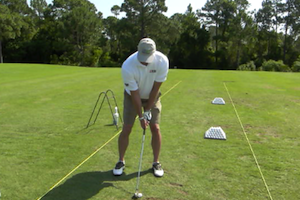
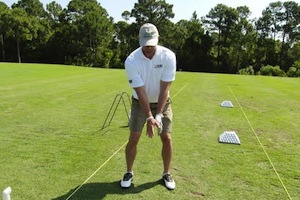
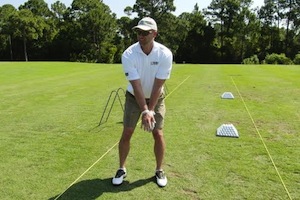
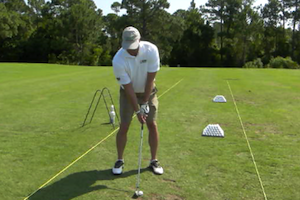
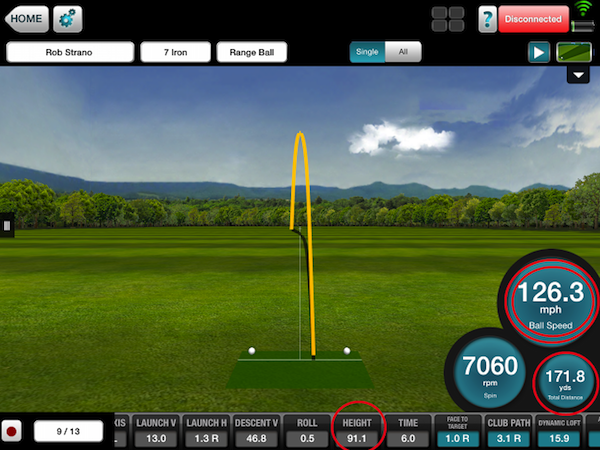
















Pingback: NFL Quarterback gets a lesson in athletic posture | Spacetimeandi.com
Alex
Aug 15, 2014 at 3:47 pm
Generally good article and a solid point, but you don’t explain what changes you made.
From what I can glean, the main two are that (1) you set him up with his spine angle slightly away from the target rather than towards it, and (2) you had him bend from the hips rather than from the waist.
The spine angle change is big because it allows him to rotate his shoulders freely without leaning into the target (aka two way miss slice/hook city).
The hips/waist change straightened out his back (no longer rounded) and encourages a full hip turn with a relatively constant spine angle (when in conjunction with change (1)).
David
Aug 21, 2014 at 6:43 pm
Watch the video